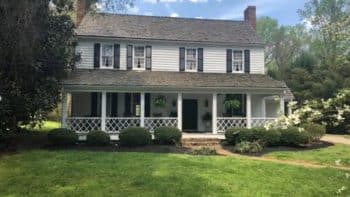NEWS
Walnut Grove: a Davidson History Column by Nancy Griffith
 When we think of plantation houses in Davidson, our minds usually turn to Beaver Dam, the Davidson plantation on Concord Road. There was, however, a large plantation much closer to downtown, called Walnut Grove. The owners, the Johnston family, farmed a large tract of land just south of town, where Whit’s and the Crazy Pig are now.
When we think of plantation houses in Davidson, our minds usually turn to Beaver Dam, the Davidson plantation on Concord Road. There was, however, a large plantation much closer to downtown, called Walnut Grove. The owners, the Johnston family, farmed a large tract of land just south of town, where Whit’s and the Crazy Pig are now.
As I mentioned in my recent article on slaveowners in Davidson, the first of the Johnston family to settle in America was Patrick Johnston, an expert weaver who arrived from Ireland in 1787, at the age of 26. He married Ann or Annie Wall (sometimes described as Walls or Wallis) in 1794. In 1810, they were living in Mecklenburg County with Captain B. Willson, and by 1820 they had their own household. Two members of the family were engaged in agriculture and two in manufacturing. There were three free white people in the family and 30 enslaved people. The older Johnstons remained in Mecklenburg County until Ann’s death in 1843 and Patrick’s in 1844.
It was Patrick’s eldest son, James (1801-1860) who lived at Walnut Grove. He married Anna Bona Torrence in 1824 and built the Walnut Grove plantation house in 1831. He served as the first postmaster of the village of Davidson College when it was founded in 1837. He was a prosperous farmer who owned $6000 (over $240,000 today) in real estate in 1850. According to historian Chalmers Davidson, the Walnut Grove plantation house was relatively small, and like many houses of that era was framed, two stories high, and sported two end chimneys and a one-story porch. It was surrounded by outbuildings, most likely a kitchen, a smokehouse, a well house, a carriage house, storage buildings, and the plantation office.

Walnut Grove’s construction was probably similar to that of Beaver Dam, the Davidson’s plantation pictured here.
The rather small house, however, belies the luxury of the Johnston’s lifestyle. In the time before manufacturing became common, plantation owners were what Chalmers Davidson called “the aristocracy of the Piedmont.” James Johnston likely dressed in velvet and silk. His house had a library and a quantity of expensive furniture, rugs, and draperies. When his personal property was dispersed in 1860, it was sold for $7400 (approximately $280,000 today). In addition to the house and outbuildings, his homeplace featured a deer park and was adorned with peacocks and a beautiful garden. Historian Mary Beaty reports that Johnston was somewhat of a local character. Being “rather portly,” he found it difficult to ride horseback, and used a cart pulled by goats in silver harnesses. When his estate was liquidated, the cart and silver harness were sold for $25 (about $550 today).
According to Davidson, Ana Johnston was injured in a carriage accident and spent some of her later years in a wheelchair. One of her descendants remembered her as “a woman of fine character, patient and intelligent, loving all young people and in turn loved by them. A gentlewoman and a Bluestocking Presbyterian, she spent much of her time reading.” The Johnstons were able to educate two of their sons, Patrick and Alexander, at the fledgling Davidson College, and their daughter was educated at Salem Academy. Both Ana and James died in 1860, just prior to the Civil War.
Although plantation life ceased after the Civil War, Johnston descendants continued to be influential in Davidson. While some of the Johnston children died young, others married into other longtime Davidson families, among them the Sheltons and the Potts. The extensive Shelton properties south of Davidson were a result of Minnie Johnston’s marriage into the Shelton family. They were also connected by marriage to the Torrence, Stough, Withers, Thompson, Helper, and Wooten families. In addition, a number of Davidson families descended from Johnston slaves, including those of Patrick Johnston and Davidson barbers, Walter and Ralph Johnson.
Nancy Griffith
Nancy Griffith lived in Davidson from 1979 until 1989. She is the author of numerous books and articles on Arkansas and South Carolina history. She is the author of "Ada Jenkins: The Heart of the Matter," a history of the Ada Jenkins school and center.


